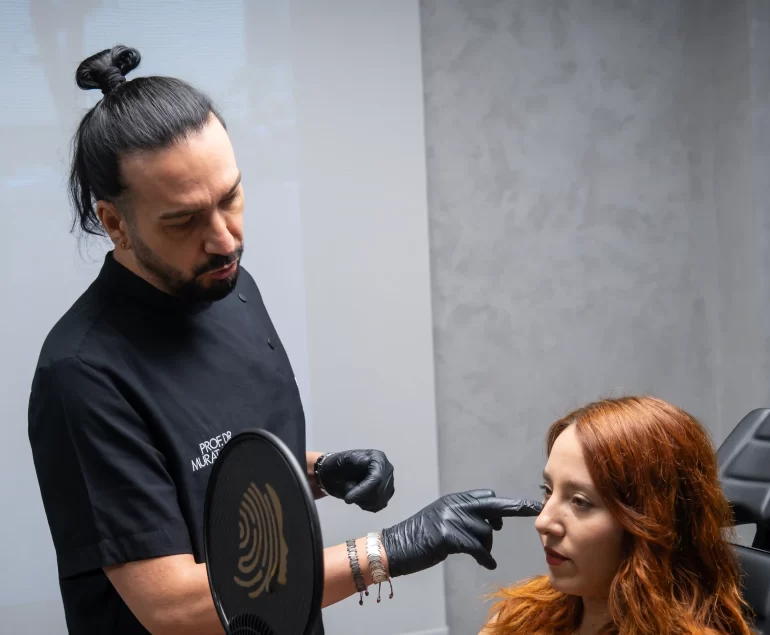Revision rhinoplasty stands as a testament to medical advancements, offering individuals another opportunity to align their appearance with their aspirations. Nevertheless, this complex procedure harbors its own set of challenges.
Optimism flourishes with the prospect of refinement, yet the shadows of potential complications loom. Diligent selection of a surgeon with exemplary skills becomes paramount. Indeed, success hinges on meticulous preparation. Therefore, while uncertainties exist, the pathway to a satisfactory outcome is paved with informed choices and professional expertise.
Table of Content
Enhanced Risk of Scar Tissue Formation
Following an initial surgery, the nasal structure becomes inherently more susceptible to the formation of dense scar tissue. Consequently, this phenomenon can mar the aesthetic harmony of the nose, detracting from the smooth contours that patients desire.
Furthermore, the accumulation of scar tissue bears the potential to impede nasal airflow, thus complicating breathing functions. The intricacies of dealing with previously altered tissues underscore the necessity for:
- A surgeon’s adeptness in navigating the unique challenges posed by scarred nasal landscapes.
- The application of refined surgical techniques aimed at minimizing additional scarring.
- Post-operative care strategies designed to support optimal healing and reduce scar visibility.
As such, while the pursuit of aesthetic refinement and functional improvement motivates individuals to undergo revision rhinoplasty, the heightened risk of scarring demands careful consideration. Through the collaborative efforts of patient and surgeon, strategies to mitigate this risk can be effectively implemented, paving the way for a more favorable outcome.
Risks to Blood Flow Integrity in Secondary Rhinoplasty
Revision rhinoplasty presents unique challenges, not least of which pertains to the nose’s intricate vascular system. The operation, especially when addressing comprehensive adjustments, significantly heightens the risk of vascular disruption.
This fragility stems from the necessity to navigate through scar tissue, which may obscure the original anatomical landmarks. As a result, ensuring adequate nourishment to nasal tissues becomes a precarious endeavor. Consequently, two primary complications may arise:
- Skin necrosis, where tissue death occurs due to insufficient blood supply.
- Prolonged recovery periods, exacerbated by the compromised healing environment.
Hence, the surgeon’s expertise in maneuvering through this labyrinth of vessels is critical. Adequate blood flow is the lifeline for successful healing post-surgery. Moreover, a detailed preoperative analysis is indispensable for minimizing these risks.
Ultimately, awareness and strategic planning form the cornerstone of mitigating potential adverse effects on the nasal blood supply during revision rhinoplasty.
Respiratory Challenges Following Revision Rhinoplasty
Such alterations, while aimed at enhancing form or correcting previous errors, might inadvertently restrict airflow. This surgical endeavor, therefore, can become a double-edged sword.
On one hand, it holds the promise of an improved nasal appearance and function; on the other, it poses potential risks to the very essence of nasal functionality – breathing. The consequences of compromised nasal passages are not trivial. They include:
- Increased difficulty in breathing, which might become apparent not just during physical exertion but also in moments of rest.
- A heightened sense of congestion, leading to discomfort and an incessant need for relief.
- The potential development of sleep apnea, a condition marked by periodic cessation of breathing during sleep, can profoundly impact one’s quality of life.
Thus, the decision to undergo revision rhinoplasty demands a careful consideration of these risks. Furthermore, it underscores the importance of selecting a surgeon with a deep understanding of the delicate balance between form and function.
Suboptimal Aesthetic Results in Revision Rhinoplasty
Pursuing perfection through revision rhinoplasty carries inherent risks, among which achieving less than satisfactory aesthetic outcomes looms large. Despite the surgeon’s expertise, certain factors contribute to these challenges:
- Scar tissue from previous surgeries may restrict modifications.
- The unique anatomy of each patient sets limits on achievable changes.
- Unforeseen complications during surgery can derail expected results.
Each of these elements plays a crucial role in the complexity of revision procedures. Scar tissue, for instance, can not only limit the extent of modifications but also affect healing post-surgery. Similarly, the patient’s unique nasal structure might not accommodate all desired alterations, making it imperative for expectations to be realistic from the onset.
Moreover, even with meticulous planning, unexpected issues during surgery can impact the outcome. Hence, while revision rhinoplasty offers a path towards aesthetic enhancement, it also demands an acceptance of its limitations and uncertainties.
Elevated Infection Risks in Subsequent Nasal Surgeries
Undergoing a second or subsequent rhinoplasty inherently presents a higher complexity than the initial procedure. Consequently, the journey toward perfecting one’s nasal appearance through revision rhinoplasty carries an augmented risk of infection.
This potential setback can significantly impede the healing process, occasionally leading to scarring or additional complications that mar the desired outcome.
In light of these concerns, the emphasis on stringent sterile practices during surgery cannot be overstated. Furthermore, adherence to a comprehensive post-operative care regimen is critical for mitigating infection risks. Key components include:
- Regular cleaning of the surgical area with prescribed solutions
- Timely administration of antibiotics, if prescribed, to prevent infection
- Avoidance of activities that could compromise the nasal area’s integrity
Hence, the path to achieving aesthetic goals via revision rhinoplasty necessitates a careful balancing act. By prioritizing impeccable surgical standards and diligent aftercare, the heightened risk of infection can be substantially reduced, paving the way for a smoother recovery and the attainment of the envisioned nasal harmony.

1976 yılında İzmir’de doğan Prof. Dr. Murat Songu, İzmir Atatürk Lisesi sonrası 1994 yılında Ege Üniversitesi Tıp Fakültesi’ne girdi. Kulak Burun Boğaz Hastalıkları uzmanlık eğitimini Celal Bayar Üniversitesi’nde tamamladı. 5 Eylül 2014 tarihinde Ankara Dışkapı Yıldırım Beyazıt Hastanesi’nde yapılan sözlü sınavı ile “Kulak Burun Boğaz Hastalıkları Doçenti” olmaya hak kazandı. Türk Kulak Burun Boğaz ve Baş Boyun Cerrahisi Derneği Bursu’nu kazanarak Şubat 2016 – Mayıs 2016 tarihleri arasında Amerika’da Pittsburgh şehrinde UPMC (University of Pittsburgh Medical Center)’da Robotik Cerrahi Ünitesi’nde çalıştı. 2 Nisan 2021 tarihinde “Kulak Burun Boğaz Hastalıkları Profesörü” olmaya hak kazandı. Evli ve iki çocuk (Ayşe Songu, Selim Songu) babasıdır.




